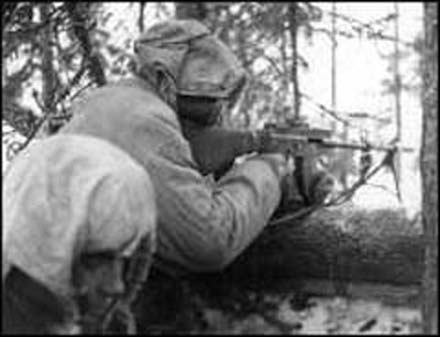Battle of the Atlantic
- The British steamer Jevington Court (4544t) from convoy FS-103 sinks on a mine about 8 miles from the Cromer Knoll Light Vessel. This is a result of the German destroyer mine-laying operation of February 9th. The entire crew is picked up by the British minesweeper Dunoon.
- The British steamer Clan Morrison (5936t) from convoy FN-102 sinks on a mine in the Wash. This is a result of the German destroyer mine-laying operation of February 9th. Survivors are picked up by the British minesweeping trawler Nogi.
- The British steamer Royal Archer (2266t) sinks about 7 miles northeast of Inchkeith Island from a mine laid by U-21 on 3 November 1939. 27 crewmen and 1 gunner are rescued.
| Class | Type VIIB |
| CO | Kapitänleutnant Harald Grosse |
| Location | W of Orkney |
| Cause | Depth charge |
| Casualties | 42 |
| Survivors | None |
Britain, Home Front
Chamberlain, in Birmingham, condemns Nazi war aims: 'destruction of this nation and domination of the world', but declares his continued willingness to reach a settlement with an alternative German government.
[Diplomatic Relations
- A conference of Scandinavian Foreign Ministers is held at Copenhagen (Feb 24-25). The minister re-assert 'absolute neutrality' of Denmark, Norway and Sweden.
- A German-Italian trade agreement is made giving Italy a greater supply of coal.
Finland - Winter War
Day 87
On the Karelian Isthmus the Finnish 23rd Div counterattacks in order to improve their defensive positions to the east of Lake Näykkijärvi. The counterattack begins at 2:30a.m. but almost immediately breaks down and the Finns return to their defensive positions. In the north the Finnish guerillas operating in Salla are beginning to suffer because of countermeasures employed by the Soviets. The independent Company Kojonen pulls off a surprise attack on a Red Army logistics center at Kuusivaara in Salla where the Soviets lose heavily. In Petsamo, a 180-man strong Soviet ski company attacks Heteoja, bringing to an end a phase of the guerilla activity which had lasted almost 2 months. They become surrounded by the Finns, but about half are able to break out. In Kuhmo, the Finns take the Reuhkavaara 'motti'. There are 174 Russians killed. Finnish casualties are 3 dead and 5 wounded. A considerable amout of materiel is captured including 2 tanks, 4 trucks and over 200 small arms.
Finns Counterattack on the Karelian Isthmus |
 |
Germany, Home Front
Hitler boasts of his achievements in a speech at Munich on the 20th anniversary of the founding of the Nazi Party and claims: 'Germany would not have lost the last war if I had been Reichschancellor in 1918!'.
[Germany, Planning
Revised orders for the attack in the west are issued. The 'Manstein Plan' is adopted by the German Army High Command. OKH has been conducting exercises throughout the winter and especially in the early days of this month because of dissatisfaction with the attack plan. Following von Manstein's conversation with Hitler on the 17th and an OKH presentation to him on the 18th it has been decided to revise the plans to emphasize the role of Army Group A and an attack through the Ardennes. 5 Panzer divs with motorized infantry and Ju-87 Stuka divebombers are to smash through weak points in the Allied line, the hilly and 'impassable' Ardennes Forest, then to cross the River Meuse at Sedan and drive across northern France to the Channel. This will cut off the main Anglo-French forces which are to be lured into Belgium by the German 6th Army. As far as technique goes the plans are fairly traditional. The emphasis is still not yet fully on the possibilities of the Panzer advance. von Rundstedt and von Bock, who will be the principal commanders are, despite their considerable abilities, wedded to the conventional infantry-based ideas. Although the direction of the attack is certainly bold, the old school see early problems when it becomes necessary to cross the Meuse. The tank enthusiasts, like Guderian, are more concerned about exploiting the advance after the crossing. Preparations for this 'knock-out blow' are to be completed by Mar 7.
[North Sea
The Swedish steamer Bohus (1761t) is taken in prize by German warships. It is later renamed Gerrit Fritzen and placed in German service.
[